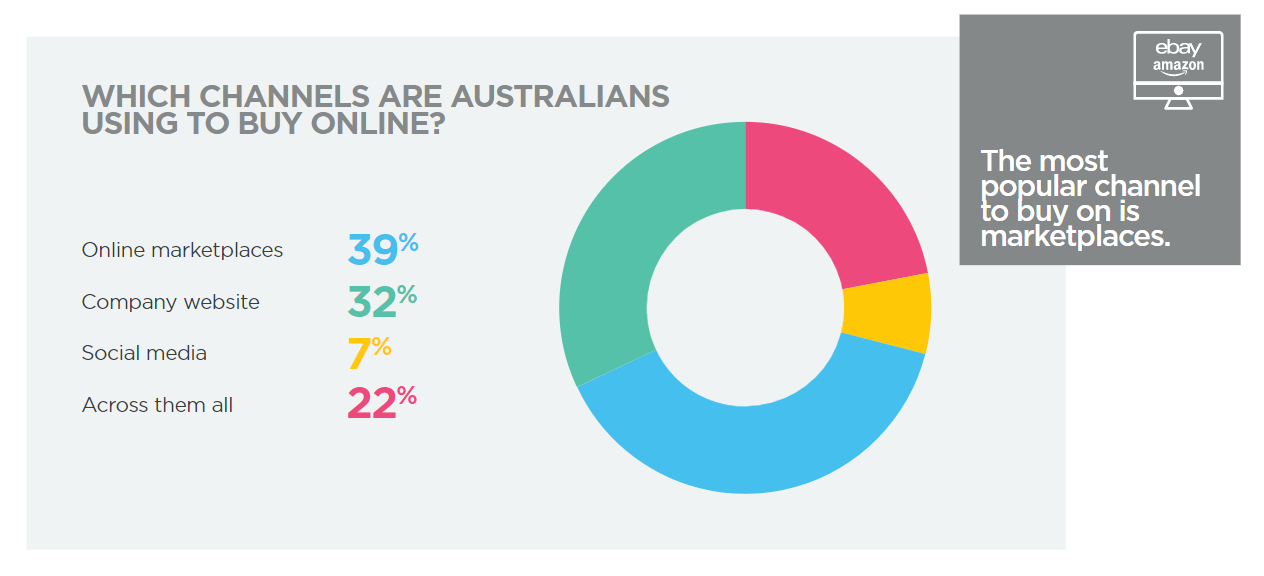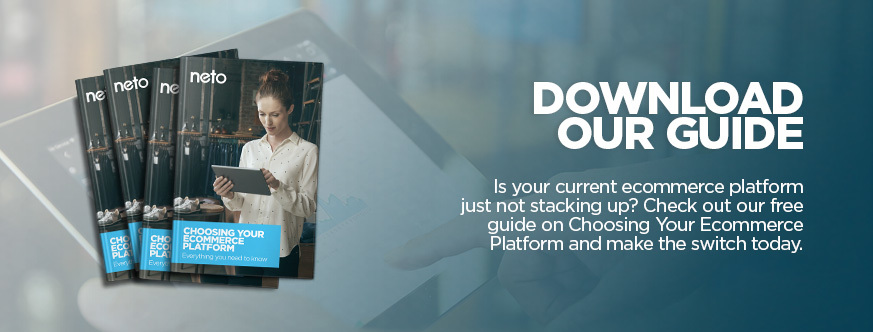
Ecommerce and Retail

While much of the workforce is well and truly settled back into swing of things after a relaxing break, retailers across the country are bouncing back after a busy Christmas and holiday trade season.
It was a good news period of sales with retailers experiencing a solid Christmas, despite fears that the launch of Amazon Australia would poach consumers’ holiday dollars. In fact, reports suggest the launch had surprisingly little impact, with sales from Boxing Day through to New Year exceeding expectations.
But it’s the online domain that experienced significant growth last year and presents a lot of opportunity for retailers in the year to come. In 2017, Australians spent an estimated $23.5 billion on online retail —which accounts for around 7.7% of total retail. The NAB Online Retail Sales Index reported 14.4% year on year growth in online sales in November 2017, and a monthly growth rate of 4.7%—the largest since 2014. This is compared to just 0.5% monthly growth for traditional retailers.
Online sales for multi-channel retailers (who sell both in physical stores and online) are expected to grow, too, with Commbank forecasting a jump from 29% to 35% of total sales.

So what else can we expect from the year ahead? Here are the trends to watch this year.
Amazon Australia finally arrived on our shores amidst huge fanfare last year, to join the likes of eBay, Asos, Trade Me and Catch (formerly Catch of the Day). And whilst there were mixed feelings from retailers, shoppers are turning to marketplaces like Amazon more and more—research published in the Neto State of Ecommerce Report revealed that online marketplaces are the most popular channel to buy on, with 39% of shoppers surveyed preferring this channel compared to 32% for company websites. At first glance, the figures can be a little daunting but we advise retailers not to view online marketplaces as competition but as yet another sales channel in their arsenal.

These online marketplaces enjoy a level of brand recognition and loyalty that other retailers can only dream about, in addition to huge existing audiences and even bigger marketing budgets—all of which ecommerce retailers can leverage, at little cost.
Online marketplaces are an important addition to any retail strategy and the benefits go well beyond marketing, allowing you to tap into new and innovative technological advances that may not be possible for you as an individual retailer. The trick is to have technology (and a retail management platform) that is up to the challenge so that you can manage inventory across multiple channels, work in real time and handle different shipping requirements.
| Related reading: 95% of retailers to sell on Amazon and other Marketplaces in 2018
Omni-channel and multi-channel are terms that are often used interchangeably but the truth is, multi-channel is all about you, the retailer, while omni-channel is all about your customer. There’s no longer a typical, linear path to purchase. Your customer may be standing in your store while researching and even purchasing the same product you sell, from one of many online channels.
But this doesn’t mean that bricks and mortar is dead. Research suggests that customers still want to try (or touch) before they buy, with 64% of customers searching for products online after having seen them in store. Customers also expect retailers be able to check the availability of products online or at alternative stores, and expect to return products purchased online, in store.

Serving customers across a range of channels allows consumers to purchase when and where they want and with utmost convenience. For the customer, it’s more about the buying experience than the selling message so you need to think like them and have an agnostic approach to your sales channels by providing a solution that suits every kind of customer.
The growing prevalence of marketplaces like Amazon Australia will exert pressure on retailers to provide an enhanced customer experience. As Amazon builds out its infrastructure and introduces Fulfilment by Amazon (FBA) and its priority membership program, Amazon Prime (which offers 2 hour shipping in the United States) retailers will need to speed up their processes to remain competitive.
Australians now expect fast delivery as a standard; geographical distance is no longer an excuse. Clothing and accessories marketplace, The Iconic, has long offered same day delivery for metro areas, and gifting retailer, Edible Blooms, partnered with Uber recently to offer one hour delivery for $5 in some areas.
The notion of being fast extends further than simply getting products to customers; being able to service customers efficiently in-store, respond quickly to complaints and enquiries, and assist customers to navigate quickly through your ecommerce site, using technologies like one-page checkout, will be key in 2018.
Go back five or ten years ago and these terms were the stuff of sci-fi movies. But now they are becoming an important part of the retail scene and even household names—think Amazon’s Alexa and Google Home’s AI-powered, voice activated in-home assistants. These ‘speakers’ become familiar with your voice and learn your preferences over time, playing music, answering questions and purchasing products for you via voice search.
Voice search already accounts for 20% of mobile searches, and is predicted to account for 50% of all searches by 2020, which means optimising for voice search will become just as important as text."

The other area where machine learning and AI will make a big difference is in personalisation. Machine learning algorithms are already being applied to ecommerce search engines to show customers product recommendations that are closely tailored to your own preferences, rather than based on other shoppers’ purchase behaviour. Similarly, Pinterest’s recent chrome extension update enables users to select a photo and ask Pinterest to find similar items using image recognition software.
Artificial intelligence also hopes to make the sales process more efficient. In fact, The North Face has already adopted IBM’s Watson solution to match customers to their perfect outdoor jacket. By asking customers questions, allowing voice input and even incorporating regional weather conditions, it’s matching products to consumer needs, quickly and from a customer’s perspective, easily.
Whilst your everyday in-home robot personal assistant is still some way off, retailers are beginning to incorporate robots for a variety of uses including in-store customer service, inventory tracking and warehouse management. Japan’s Softbank mobile stores have rolled out a customer service robot called 'Pepper' to 140 stores to interact with customers, answer questions and give direction, similar to US home improvement retailer’s ‘Lowes Lowebot’, a rolling kiosk that allows customers to look up products information.
Many large warehouses are also looking to robots to speed up and automate the fulfilment process. Amazon’s fulfilment centres employ over 45,000 robots in its warehouses to fulfil orders and Catch recently introduced an automated storage and retrieval system which uses robots to retrieve the goods, increasing their order picking by 4,000 orders a day and reducing the number of pickers from 60 to just four.
But the more familiar of the robots that you’ve probably come across is the chatbot - an interactive software usually found in apps, live chat, email and sms, which uses predictive capabilities and artificial intelligence to respond to visual, vocal and written cues. The result: a conversation that feels more human than computer.
Many retailers are already using chatbots to automate the customer service process and that figure is likely to rise, with research by Oracle indicating that 80% of business already use or intend to implement chatbots by 2020.
Take Starbucks’ newest release, the My Starbucks Barista app: it allows customers to speak to a chatbot and place their coffee order, asking contextual follow up questions so that it gets even the most complicated order correct.

Big brands are the early investors in this space and although we may not see a huge trickle down to smaller retailers just yet—stay tuned—as with any new advances there’s always a point where it becomes not just accessible but affordable for all. Plus, if you’ve adopted our first tip to join an online marketplace, you’ll be in the perfect position to reap the rewards of their investment in these kind of technologies.
| Related reading: The Future of Retail in Australia.
Retailers have so much information available to them - customer data, inventory and stock, social media and website analytics. 2018 will be about tapping into this data and translating it into actionable insights for customer service, sales, marketing and operations. Data will enable businesses to improve customer interactions and build loyalty by personalising the customer experience with product recommendations for example, or, by providing up-to-the-minute details on payments, orders and delivery.

Unlike machine learning and artificial intelligence, big data isn’t just for big retailers with big budgets. Here’s some tips to get on board:
Set yourself up for success by properly capturing and storing the data you need to make decisions long term. Depending on the lifecycle stage of your business, these tools may vary in cost and complexity, but at the very least, every ecommerce retailer should invest in properly implementing Google Analytics Enhanced Ecommerce. Platforms like this are low cost and relatively simple to implement. They will allow you to capture the data around shopping behaviours that impact sales and accurately track ROI across channels.
With so much data available these days, it’s important to set clear intentions around the goals you want to achieve before investing time and money in analysing and actioning the data you have available. Start by setting one specific and measurable goal that will help you to achieve success in your business. For example, you might set a goal of improving the sales conversion rate on your product pages by 5%.
Tools like Optimizely and Google Optimize make it easy for you to create A/B, multivariate, or redirect tests to change just about anything on your web store and then quickly determine the impact on customer behaviour. For example, you might use Google Optimizer to create an A/B test to show 50% of all traffic a green buy button vs your regular black buy button.

After allowing sufficient time for your experiment to run, use the inbuilt reports provided by platforms like Google Analytics to report on the success or failure of your test. If necessary, tweak your hypothesis and retest until your objectives are met.
Facebook recently announced that it would be tailoring its newsfeed to focus on family and friends, therefore reducing the organic reach of business posts… yet again. However, we know that a massive 78% of consumer purchase decisions are influenced by social media, so, regardless of any algorithm changes, you still need to be active and engaged online.
This means communicating with relevant, thoughtful social media content, responding to those who engage with you and integrating your platform with a means for customers to purchase. And as for the constantly changing Facebook Algorithm, this means that advertising is no longer a ‘nice to have’ but a necessity. Boosted posts will increase your reach and if you delve deeper and add the Facebook pixel to your website, you’ll cleverly retarget visitors by following them through their social media, both Facebook and Instagram, subtly reminding them that they have unfinished business with you. And whilst only 7% of sales are currently conducted through social media, the channel will most certainly continue to grow in 2018.
| Related reading: 3 steps to maximise your social media ROI
This year won’t be without challenge for retailers, but it also holds massive opportunity and reward for those who are smart about it. The key to tapping into each of these trends and predictions for 2018, is a scalable, multi-channel retail platform. As a retailer, investing early in technology and the best software for the job will mean giving your business the very best chance for growth and success.
Need some tips on how to select the best retail platform for your business? Check out our guide to Choosing your ecommerce platform.
